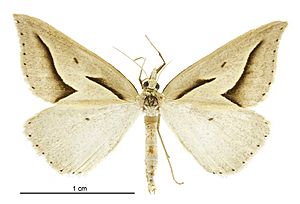Samana acutata facts for kids
Quick facts for kids Samana acutata |
|
|---|---|
 |
|
| Male | |
| Scientific classification | |
| Kingdom: | |
| Phylum: | |
| Class: | |
| Order: | |
| Family: | |
| Genus: |
Samana
|
| Species: |
S. acutata
|
| Binomial name | |
| Samana acutata Butler, 1877
|
|
Samana acutata is a species of moth in the family Geometridae This species is endemic to New Zealand. It is classified as "At Risk, Relict" by the Department of Conservation.
Contents
Taxonomy
This species was first described by Arthur Gardiner Butler in 1877 using a specimen that was collected from Christchurch, in the South Island and was obtained from J. D. Enys. George Hudson discussed this species in his 1898 book New Zealand moths and butterflies (Macro-lepidoptera). He later discussed and illustrated this species in his 1928 book The Butterflies and Moths of New Zealand. The holotype specimen is held at the Natural History Museum, London.
Description
Butler described the species as follows:
Primaries pale straw yellow ; an oblique interno-basal litura, a dot at the end of the cell, and a discal transverse line terminating in an acute < -shaped angle, piceous ; the discal line diffused externally ; a marginal series of black dots ; secondaries white, with the fringe creamy; a marginal series of black dots; thorax pale straw yellow, abdomen white : primaries below pale testaceous, whitish on internal area ; markings (excepting the marginal dots, which are united by a slender brown line) only visible through the wing ; secondaries white, the costal area tinted with testaceous, and sparsely irrorated with brown ; a small black dot at the end of cell ; a marginal series of black dots ; fringe creamy : body below pale straw yellow. Expanse of wings 1 inch 2 lines.
Distribution
This species is endemic to New Zealand. S. acutata can be found in Mid Canterbury and Central Otago. It is now extinct at its type locality.
Life cycle and behaviour
Larvae of this species have been found in January and in March. The adult is on the wing in September and October. Hudson stated this species is attracted to light.
Host species and habitat
The host species for this moth are the New Zealand native brooms in the genus Carmichaelia including Carmichaelia australis and Carmichaelia appressa. The species is known to inhabit dune ecosystems. It has also been found in habitat containing gorse and mānuka.
Conservation status
This moth is classified under the New Zealand Threat Classification system as being "At Risk, Relict". This species is threatened as a result of change of habitat, in particular the loss of its host species due to farming and urban development. It is also at risk from weed invasion from plants such as sea spurge.
Images for kids
 | Selma Burke |
 | Pauline Powell Burns |
 | Frederick J. Brown |
 | Robert Blackburn |


